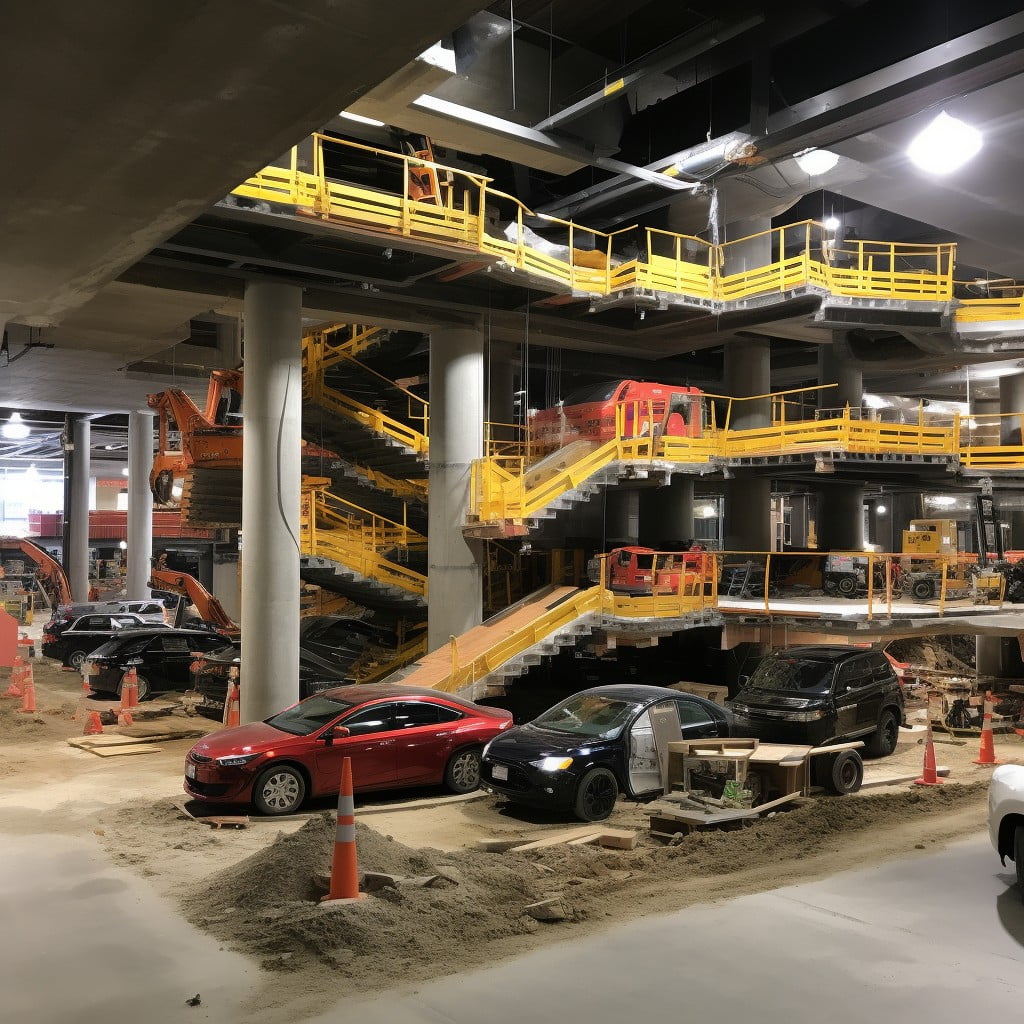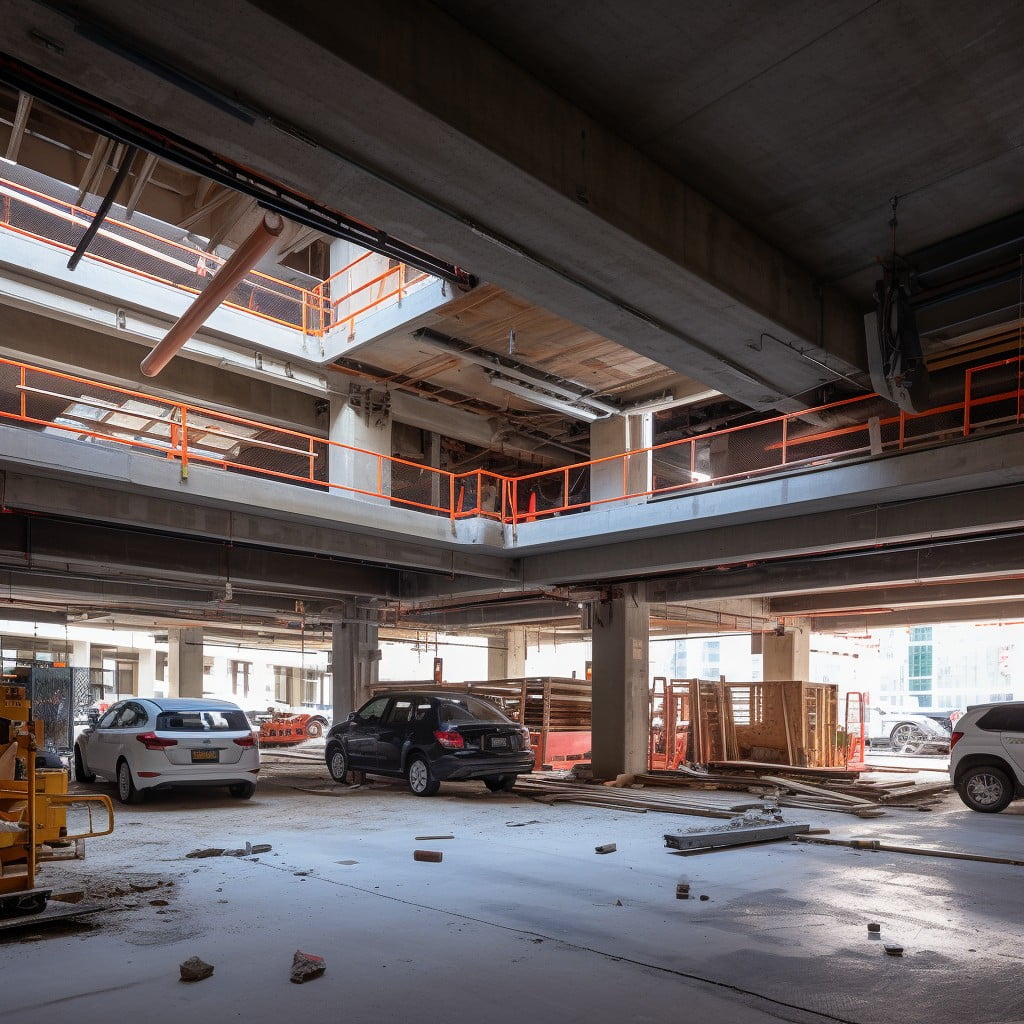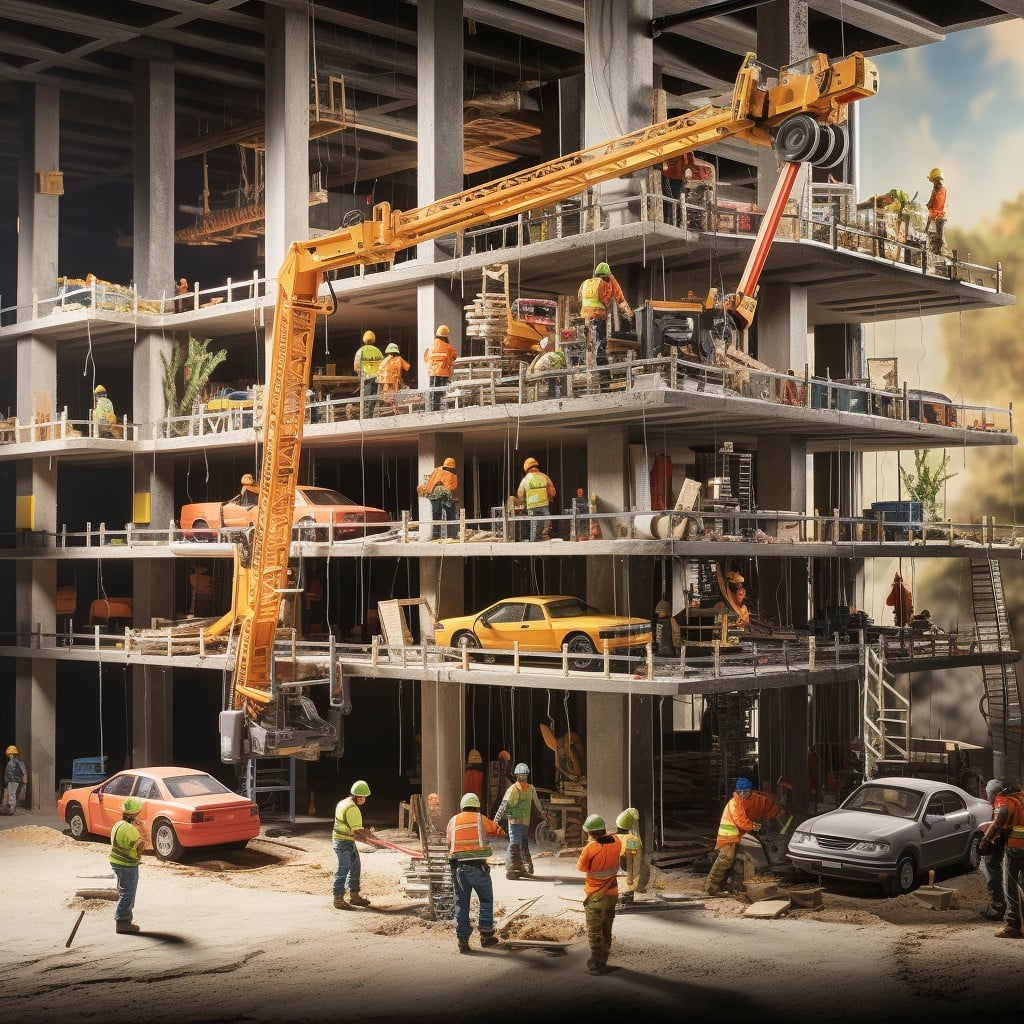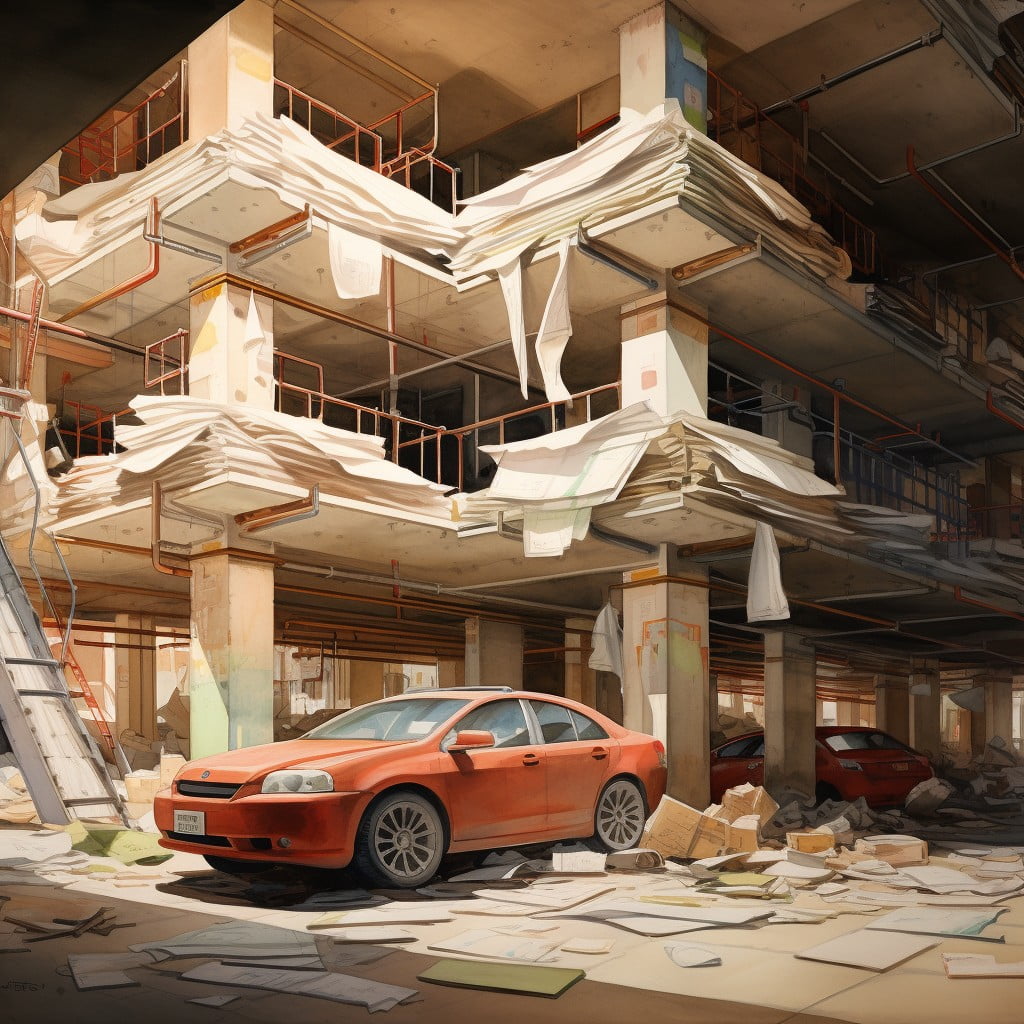Exploring the various factors that impact the total cost of building a parking garage can provide valuable insight for those considering this significant investment.
Building a parking garage is a significant investment with various factors influencing the overall cost. The average cost to construct a parking garage ranges from $50 to $80 per square foot, depending on factors such as the size of the garage, location, materials used, and the complexity of the design.
This doesn’t include the cost of land or any site improvements needed before construction can begin.
In the following sections, we’ll delve into the specifics of each cost component, providing a comprehensive view of what you can expect when planning to build a parking garage.
Key takeaways:
- Average cost to build a parking garage: – per square foot
- Factors influencing cost: size, location, materials, design complexity
- Land and material costs are significant expenses
- Labor costs depend on wage and project complexity
- Insurance, permits, and miscellaneous costs should be considered
Cost Factors in Building a Parking Garage

There are several critical elements to consider when estimating the cost of constructing a parking garage, making the budgeting process a complex one. First, geotechnical conditions play a significant role. Naturally, stable soil types and flat terrains make construction easier and cheaper. Conversely, steep, rocky terrains or those requiring significant soil stabilization work increase expenses.
The size of the garage determines a large portion of the cost, as more extensive structures demand more materials and labor. Additionally, design factors, such as the number of floors and the complexity of architectural features, also influence the expense. For instance, incorporating elevators, stairwells, or underground levels will undoubtedly push costs upward.
Additionally, regional factors can have a surprising impact on the total outlay. The local costs for labor and materials vary widely, and local code requirements can also add cost. For example, seismic requirements in one area may necessitate more expensive structural solutions than a similar garage in a less seismically active area.
Finally, the specific materials used in construction have a significant cost influence. Choice between cast-in-place concrete, steel frame, or precast concrete can wildly affect both initial construction costs and long-term maintenance expenses. Therefore, selection should be carefully considered during the initial design phase.
Role of Land and Material Costs in Parking Garage Construction

Acquiring land is the first step in constructing a parking garage and can significantly contribute to the total costs. The price of the plot can vary greatly depending on its location, size, and zoning restrictions. Urban areas tend to be more expensive for acquiring and preparing land due to higher property prices and stricter building regulations.
Materials form another significant portion of the expenditure. Concrete, the most common material used in garage construction, fluctuates in price depending on factors such as transport costs and local market conditions. Steel, another substantial component, is subject to global market prices and can lead to unforeseen cost overruns. Selecting high-quality, durable materials initially can entail a higher outlay, but can also reduce long-term maintenance and repair costs.
Green alternatives, though potentially costlier initially, can offer long-term savings through energy conservation, waste reduction, and eligibility for government subsidies or tax incentives. Other material-related costs include necessary machinery and tools to manipulate these materials, costs that also need to be factored into the budget.
The Influence of Labor Costs On the Total Expense

Labor costs often constitute a substantial portion of any construction budget, including the building of a parking garage. The amount you can expect to spend on labor primarily hinges on two factors: the hourly wage of construction workers and the complexity of the project.
Hourly wages for construction workers vary significantly depending on their level of expertise and geographic location. Professionals skilled in handling highly specialized tasks, like building structural frames, often command a higher wage.
The complexity of your project dictates the duration of construction work. More intricate designs may require additional man-hours, subsequently driving up costs. Furthermore, unforeseen complications can extend the construction timeline, hence necessitating higher labor costs.
Remember, a healthy balance between affordability and quality should be struck when budgeting for labor. Opting for the cheapest labor may compromise quality, safety, and longevity of the parking garage.
How Insurance and Other Miscellaneous Costs Impact the Total Expense

When planning for the total cost of a parking garage, insurance coverages and miscellaneous costs can hold an influential role. Depending on the specific project, these can be less apparent than material or labor expenses but remain an indelible part of the project’s big financial picture.
Firstly, insurance policies protect against an array of risks associated with construction. They cover potential damage to the property, workplace accidents, and even public liability. In fact, many contractors and construction firms must show proof of insurance coverages before even starting the job.
Then come those other often-overlooked expenses labeled miscellaneous. Key among them is the cost of construction permits which various local governments require for safety and regulation. Moreover, fees for architectural plans, engineering consultations, and site inspections can quickly add up.
Finally, don’t forget potential emergency costs. Delays due to weather conditions or unforeseen site issues may attract additional labor and material expenses. Including these in your cost analysis ensures an accurate budget plan and a successful parking garage construction project.
The Role of Electrical and Plumbing Work in Total Costs
Even with a structure up and in place, there’s still a considerable amount of work left. Electrical systems play a crucial part in modern garages. These include lighting, elevators, payment machines, and security systems such as surveillance cameras and access control points.
For a multiple-level parking garage, sufficient power supply to ensure functionality of these systems can result in a significant expense, accounting for around 10% to 15% of the total costs. Hiring licensed electricians is a must to ensure safety and proper system integration.
Plumbing work will be another requisite if the garage plan includes restrooms, drainage for rainwater, and perhaps washing areas. Costs for this can vary based on layout complexity and local plumbing rates, typically adding around 5% to 10% to the final building cost.
It’s also important to consider future energy costs. With strategic placement and selection of LED lights, motion sensors, and energy-efficient appliances, one can significantly reduce the operational costs over the long term. While the upfront cost might be high, the savings over the lifetime of the garage operation can be substantial.
Understanding Construction Equipment Expenses in Building a Parking Garage
The most significant equipment-related expenses revolve around the acquisition of construction machinery such as cranes, concrete mixers, excavators, and heavy-duty trucks, among others. In some cases, contractors may elect to rent these machines on a daily or weekly basis instead of purchasing them. The choice largely depends on the scope of the project, the total budget, and the project timeline.
Additionally, there’s the cost of smaller tools used in the construction process, such as shovels, hammers, and power drills. Alongside tools, safety equipment is a necessary expense to ensure the well-being of workers on site. This would include helmets, safety harnesses, and protective footwear.
Calculating these costs will also require consideration of fueling and maintenance costs. Construction machinery, especially heavy-duty machines, consume large quantities of fuel. Regular maintenance checks and repairs are also essential to keep the equipment running smoothly and safely, avoiding any costly hiccups in the construction timeline.
Moreover, considering the wear and tear on these tools and machines, there are repair or replacement costs. These costs might be minimal on a per-item basis for smaller tools, but for larger machinery, it can be quite substantial. Allocating an appropriate budget for these expenses is therefore crucial in developing an accurate cost estimate for constructing a parking garage.
Effect of Maintenance and Operational Costs On Long-term Expenditure
Upon completion of a parking garage’s construction, the journey towards maintaining its functionality begins. It’s crucial to consider the costs of routine and preventive maintenance, replacement of equipment, utility bills, security services and other operational fees.
Regularly scheduled maintenance is instrumental in preventing premature structural wear and tear. This can range from cleaning supplies to hire professional cleaning services for the daily upkeep. Similarly, timely repairs, such as minor cracks fixing, resealing or waterproofing procedures, can help avoid major, costlier problems down the line.
Operational costs play a big part too. This includes security measures like installing surveillance cameras or hiring security personnel to ensure a safe environment, and utility bills for lighting and ventilation systems, which tend to consume more energy in large structures such as parking garages.
One must also consider costs for eventual equipment replacement. Automated parking systems, elevators, or ticket machines, for example, may require upgrades or replacements over time.
Hence, understanding these costs will allow for more accurate budgeting and planning, ensuring the long-term feasibility of your parking garage project.
FAQ
How many cars can park in 10,000 sq ft?
In a 10,000 sq ft area, approximately 30 cars can be parked.
How profitable is a parking lot business?
A parking lot business, once operational expenses are accounted for, can provide a profit margin of about 60%, potentially yielding a profit of around $98,000 per year if running a small, 15-space lot leased at a daily rate of $30.
How much does a parking lot sensor system cost?
The cost to install a parking lot sensor system typically ranges between $300 and $500 per space, contingent upon local labor costs.
How to build underground parking?
Underground parking is constructed by employing steel sheet piles for a retaining structure and fabricating concrete floors to ensure the stability of the finished structure.
What are the must-have features in a modern garage design?
Modern garage design must incorporate adequate storage space, efficient lighting, climate control, durable flooring, and tech-friendly features like charging stations for electric vehicles.
How to maximize space in a multiple car parking garage?
To maximize space in a multi-car garage, consider incorporating efficient storage solutions, decluttering regularly, and installing car lifts or stack parking systems if feasible.
What factors influence the cost of constructing a residential garage?
The cost of constructing a residential garage is influenced by factors such as the size, design, materials, location, and whether it's an attached or detached structure.